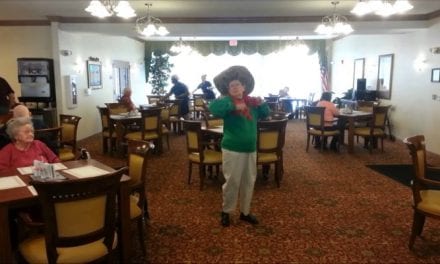In looking at the senior housing industry as a whole and assisted living more specifically, I see four realities:
In looking at the senior housing industry as a whole and assisted living more specifically, I see four realities:
1. As much as the industry would like it to be different, seniors are putting great effort and resources into growing old at home. This means when they finally make the move to assisted living, they are older than would be ideal, from the perspective of the assisted living operators. The net effect is that assisted living stays are shorter and residents require more attention, which makes the financial proposition for the community less attractive. 2. Seniors who move into assisted living present with more medications and more complex medical needs. They also require higher levels of support with activities of daily living. 3. When a senior moves to a higher level of care it does great damage to their emotional well-being, their physical well-being and their families’ well-being. Studies have shown that the fewer moves a senior makes the better off they will be in every respect. 4. While there are some great skilled nursing facilities, it is never a “lifestyle choice”. The public perception is that if you have to go into a skilled nursing facility you are close to the end of your life. It is often perceived as going to a place to die. While at ALFA in Dallas a several weeks ago I attended two breakout sessions where the presenters described a number of Assisted Living communities that are in effect, operating medical model assisted living communities. One of the presenters was Tiffany Tomasso, one of the founders and partners of Kensington Senior Living, LLC and a partner in Fountain Square Development. Prior to founding Kensington Senior Living, Tiffany was the Chief Operating Officer for Sunrise Senior Living. She is a former Past Chairman of ALFA and currently serves on the Springpoint Senior Living BOARD OF TRUSTEES.
THE KENSINGTON MODEL
Tiffany and her team took their long term care and assisted living experience and asked this question: Given what we know about seniors and the assisted living market place today, how can we create a model of care that will better serve the needs of today’s seniors in the current senior marketplace? While the Kensington Model is a work in progress here is what it looks like today:
1. They have a strong clinical framework –The average age of their seniors is 84 with a myriad of health care needs. The anchor point at Kensington is an RN with a critical care background. She leads the nursing team and effectively functions as a case manager for the residents. The team includes multiple LPNs on each shift who are responsible for both medication administration and other nursing interventions. Kensington also has agreements with a Board Certified Gerontologist, an Internist, a Cardiologist and a NeuroPsychiatrist. Each of these professionals make regular visits to the community to see patients in the on-site physician office. Each community also has a well-equipped therapy center where physical therapy, occupational therapy and speech therapy are offered 5 days per week. The Kensington communities also have a preferred partnership program with the local VNA and Hospice.
2. Best Medical Outcome – Because the community, while providing a great environment, is medically focused, their goal is to determine what resources are needed to give each resident the best possible medical outcome which results in the highest possible quality of life. This means that whenever possible services will be brought to the resident. This includes rehabilitation therapy, laboratory and mobile x-ray services.
3. The Kensington is positioned as “The Option” for physically frail seniors who want to age with dignity. This includes minimizing the likelihood of needed to move into a skilled nursing facility. This represents a major shift in thinking or at least a major shift in how the community is marketed. While most residents, who move into an assisted living community, make that decision based on need rather than lifestyle, most assisted living communities present themselves as a lifestyle choice. That said, Kensington communities are rich in amenities including all day dining, an active social program and 7 day a week transportation to medical and personal appointments.
4. One Time Choice – Making the decision to move from home to a senior housing community is a gut wrenching process for the resident and their family. The Kensington concept is that moving into a Kensington community will mean the resident and their family will have to wrestle with this decision only that one time. This means that in a very real sense, Kensington moves into a case management role. It also means great peace of mind for the family.
5. A Single Move – As important as a one-time choice is a single move. Studies show that multiple moves are particularly hard on seniors and can do great damage to the physical and emotional well-being. It can result in a shortened life expectancy. The Kensington Model says, that in almost every case, a move into a Kensington community will be the last move the resident ever has to make.
6. Memory Care – The Kensington offers two neighborhoods for memory care: one for seniors in the early to mid-stage, and one for those residents with late stage. Almost 50% of the resident total resident capacity is for memory care and both neighborhoods filled in the first 11 months.
7. Marketing and Sales – One third of the move-ins have come from professional referrals (physicians, case managers), and fifty percent of the residents have come from another care setting.
Lessons Learned
1. Families really like the idea that the resident will never need to move again. In the first 10 months of operation, only four residents have moved to a higher level of care. Of those four, two needed psychiatric intervention that the community is not equipped to provide and two residents went to an inpatient hospice.
2.The early to mid-stage memory care neighborhood has been filled with residents at the mid stage of memory loss, while those with early cognitive impairment are functioning very well in assisted living. In fact, almost half the residents in AL have mild cognitive impairment (MCI).
3.Having two physician groups has been better than having just one group. Groups provide coverage than solo physicians. These lessons have resulted in better coverage and more choices for the residents and their families. Adding specialists to the physician roster has added convenience for the families.
4.About 15% of the residents had Long-Term Care Insurance which helps to make the economics work.
5.In future designs they will create more common areas and more wandering areas for the memory care program. They will also have lighter furniture and less furniture in the memory care community. Steve Moran ++++++++++++++ Don’t miss a single issue of Senior Housing Forum, subscribe today. It is free! We do not sell or share your contact information. The posts are practical and never too long. Go to the main page of Senior Housing Forum and on the top you will see a place to enter your email to subscribe. You will receive notification when a new article is posted. You can unsubscribe at any time.
Finally: If you know anyone who is looking at emergency call systems I would appreciate the opportunity to talk with them about Vigil Health Solutions.








Steve,
Liked this article greatly. I predicted about 10 yrs ago, this would be an industry wide movement at some point. Vertical integration is seemingly inevitable. I’ve seen it occur in many, many industries and it only made sense to me, at some point it would expand rapidly in the healthcare industry.
I do have a question, I have not googled the kensington info, but curious, what state was this developed in? I am an admin/exec. director over an ALF** and an RCF in MO. It is a combination assisted living and memory care unit. I have been pushing hard with our company to adjust to the higher levels of acuity necessary to compete in the market. We are located in a very rural midwestern MO area and the Dr.s here are about 20 yrs behind in thought process regarding skilled vs assisted, not to mention the city owns the hospital, the largest snf attached to the hospital and its own Alzheimer’s unit. With this intertwinement, the medical director over most of the systems is the same Dr. and he is old school, protecting the city interests. The other Dr.s in the area, while they may technically have their own practice, are mostly grouped with in 1 clinic and are “partners”. They will rarely refer outside their city controlled market and they jump at each and every chance to pull people from any other facility, into their “preferred” providers. That makes the marketing extremely tough. I have managed to maintain and build slightly, census based upon similar thoughts as the article. I try to employ Greenhouse study style aspects as well. Residents families are marketed to the concept of “their loved one never has to leave, if they so choose”. Because we do not have a skilled license, we must utilize Amedisys for home care(skilled) orders as well as hospice. We do have, on occassion, residents who age/diminish beyond our ability to care for them, but more often than not, it is the Dr. who tells the family, they must move to a skilled facility, there in chasing the market to their control.
I guess my question really is about state laws and differences between MO regs and the state the Kensington model was created and is being run in. How do they manage their skilled needs? I would imagine, they are fortunate to be in a market where they are pretty open to higher rental fees, charges etc. to be able to afford nursing staff to perform most care duties. Where I am, the budget restraints force me to adhere as closely as possible to the state reg. of 8 hrs/building and an LPN is utilized. She is a very good nurse, but the system falls short in that this is a very economically challenged area. We then use the CMA and a few CNAs to provide the care. As you can imagine, it is very challenging. Welfare people’s numbers are more than plentiful and quality people are few and far between, making finding quality employees just as challenging as competing with the city entities for residents.
I love the Assisted aspect of the industry and see huge potential in the long term for increasing numbers based exactly upon the basis of your article. Do you have any idea, which states are adjusting their laws/regulations to support this industry? As the dollar numbers from the government decrease, I cannot help but believe, most states would see this as a cost affective alternative to the bills they currently pay for residents in snfs who really could be better served in a more home like environment.
Thank you again, for the article. Feel free to email me directly, with this and other related healthcare topics.
Mike Catron, LNHA
Mike they are currently operating in New York and New Jersey, They also have a couple of projects under development in California. Using their particular model they are very specifically targeting only those states that will allow them to operate using this model.
As I talk to operators across the country I am finding there are only a small number of states that prohibit anything but a social model assisted living. In some states the permissions are built into the regulations and in other states they are required to request special permission.
With respect to your local community, it is a tough nut to crack, but I do think figuring out why both residents and the hospital/healthcare system would benefit from having residents in your community would be key to breaking that logjam.
Steve Moran
From LinkedIn Groups:
Group: Licensed Nursing Home Administrators of America
Discussion: How Assisted Living can replace skilled nursing
Hi Steve, You are absolutley right. Research shows that seniors who move into an Independant Retirement community such as Delmanor Wynford live a healthier, happier and longer life!
Posted by Pam Palmer
From LinkedIn Groups
Group: Case Mix Reimbursement for SNF’s
Discussion: How Assisted Living can replace skilled nursing
Great Article. We have been discussing this very idea. The existing SNF infrastructure cannot support the market growth!
Posted by Regan Chorlog
I happen to be a Marketing and Admissions Director in New Jersey, and I believe the Communities that you are referring to that will allow a relatively younger clientel enter a community with healthcare is called an ALP. It represents an Assisted Living Program, but not necessarily only for the 65 and older population. However, the criteria for this program is the same 3 adl’s of LTC or AL., if it is funded by the state. Unlike an AL where the goverment tallies all the fixed income and allocates what portion the resident will pay and what portion the state pays, is a fraction of what LTC would get. The ALP program is actually low income housing or subsidized housing allowing the resident access to Room and Board with some amenities, but then the care is paid for by the state, up to xxx amount of dollars of course, but none the less depending on what your room and board rates are may or may not work in conjunction to the AL and its cost share. Look up what an ALP program is as to whether it can work in your area. Our program only works if participants are qualified for a GO-Global Options waiver. However, with the younger population coming into the facility to age in place, we also have an Assisted Living and Memory Unit.
A shift towards the medical model without equal attention to how to engage people in a way that meets them at their abilities will not result in an ideal outcome. The whole self has to be provided for and I hope the Kensington Model does that well. This means combining the medical model with spiritual, artistic, and meaningful daily experiences that ultimately improve quality of life.
Great article and concept. I totally agree that multiple moving can destroy a senior. I have noted that facilities which have multiple levels of living arrangements from independent to skilled are more apt to “push” the residents to the higher and more costly level stating they are not meeting the criteria. Sad but true— I had this happen to me personally. Since I am a nurse have worked in the field, I knew to find an assisted living which would meet all my Dad’s needs as his health declined. Congratulations to the Kensington Model!
Good article, but this is obviously a large facility with a ton of money. I’d love to see more articles in this blog geared towards smaller (under 16 residents) and mid-range (16-49 resident) facilities.
Networking is applicable to any facility, but ideas on retention of residents without having to have so many staff on board would be great to read.
Medical Models emphasis Medical, a good social model with a strong culture delivers much superior results. our average age is 89, 85% have mild to significant dementia but no locked doors, 25% die each year, yet last year we averaged only 1 overnight per resident per year only 1 911 call per 4 residents per year and all of our residents die in their suites without having to move. Perhaps the stat that we are most proud of is that on average our residents are actively participating in household activities (on average) to within 5 days of their death.
From LinkedIn Groups
Group: ALFA – Assisted Living Federation of America
Discussion: How Assisted Living can replace skilled nursing
A shift towards the medical model without equal attention to how to engage people in a way that meets them at their abilities will not result in an ideal outcome. The whole self has to be provided for and I hope the Kensington Model does that well. This means combining the medical model with spiritual, artistic, and meaningful daily experiences that ultimately improve quality of life.
Posted by Rob Liebreich
I would love to hear more about the activities that are planned for early/mid cognitive impairment. Resources are limited in this arena. Thanks.
Thank you so much for sharing. I’m actually currently living with my 92 year old Grandfather, and am acting as his primary caregiver. It can be difficult at times to take care of that as well as work and go to school full time. I worry constantly that he’s not getting the attention that he really needs at his age. I’ve been looking into some nursing homes in the area but none seem to fit quite right. I know that he will be reluctant to leave his home anyways, so I want to make the transition as easy as possible.
I also work with senior citizens every day, helping them cover the out of pocket gaps brought on by government Medicare. It is an extremely rewarding position and I thoroughly enjoy the opportunity that I am given to help these special souls out each and every day. I try and do whatever extra thing that I can that might benefit them, so I will definitely have to pass this material along to them. I know that they would really appreciate being further educated on this matter. Thanks again for sharing!
… [Trackback]…
[…] Find More Informations here: seniorhousingforum.net/blog/2012/08/23/better-than-a-nursing-home-the-kensington-model/ […]…